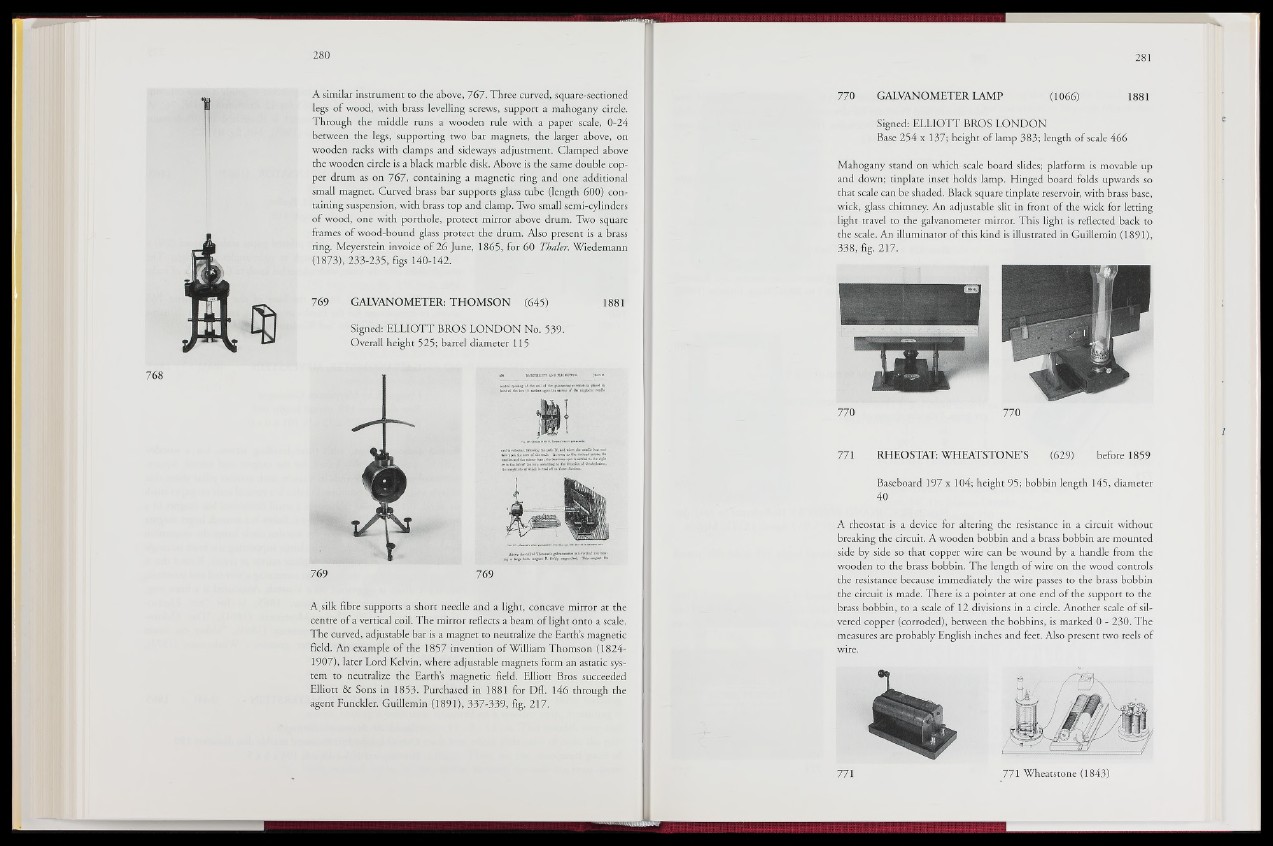
A similar instrument to the above, 767. Three curved, square-sectioned
legs of wood, with brass levelling screws, support a mahogany circle.
Through the middle runs a wooden rule with a paper scale, 0-24
between the legs, supporting two bar magnets, the larger above, on
wooden racks with clamps and sideways adjustment. Clamped above
the wooden circle is a black marble disk. Above is the same double copper
drum as on 767, containing a magnetic ring and one additional
small magnet. Curved brass bar supports glass tube (length 600) containing
suspension, with brass top and clamp. Two small semi-cylinders
of wood, one with porthole, protect mirror above drum. Two square
frames of wood-bound glass protect the drum. Also present is a brass
ring. Meyerstein invoice of 26 June, 1865, for 60 Thaler. Wiedemann
(1873), 233-235, figs 140-142.
769 GALVANOMETER: THOMSON (645) 1881
Signed: ELLIOTT BROS LONDON No. 539.
Overall height 525; barrel diameter 115
A.silk fibre supports a short' needle and a light, concave mirror at the
centre of a vertical coil. The mirror reflects a beam of light onto a sjgle.
The curved, adjustable bar is a magnet to neutralize the Earths magnetic:
field. An example of the 1857 invention of William Thomson (1824-
1907), later Lord Kelvin, where adjustable magnets form an astatic sfs.
tem to neutralize the Earths magnetic field. Elliott Bros succeeded
Elliott & Sons in 1853.lBurchased inM881 for Dfl. 146 through the
agent Funckler. Guillemin (189*1'), 337-339, fig. 217.
770 GALVANOMETER LAMP (1066) 1881
Signed: ELLIOTT BROS LONDON
Base 254 x 137; height of lamp 383; length of scale 466
Mahogany stand on which scale board slides; platform is movable up
and down; tinplate inset holds lamp. Hinged board folds upwards so
that scale can be shaded. Black square tinplate reservoir, with brass base,
wick, glass chimney. An adjustable slit in front o f the wick for letting
light travel to the galvanometer mirror. This light is reflected back to
the scale. An illuminator of this kind is illustrated in Guillemin (1891),
338, fig. 217.
770 770
'jp71 RHEOSTAT: WHEATSTONE’S (629) before 1859
Baseboard 197 x 104; height 95; bobbin length 145, diameter
40
A rheostat is a device for altering the resistance in a circuit without
breaking the circuit. A wooden bobbin and a brass bobbin are mounted
side by side so that copper wire can be wound by a handle from the
wooden to the brass bobbin. The length of wire on the wood controls
the resistance because immediately the wire passes to the brass bobbin
the circuit is made. There is a pointer at one end of the support to the
brass bobbin, to a scale of 12 divisions in a circle. Another scale of silvered
copper (corroded), between the bobbins, is marked 0 - 230. The
measures are probably English inches and feet. Also present two reels of
wire.
771 iff7! Wheatstone (1843)